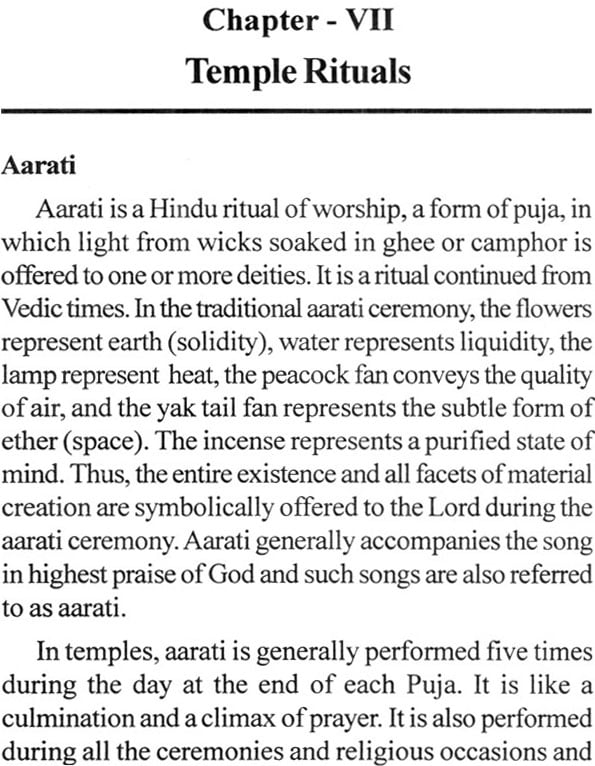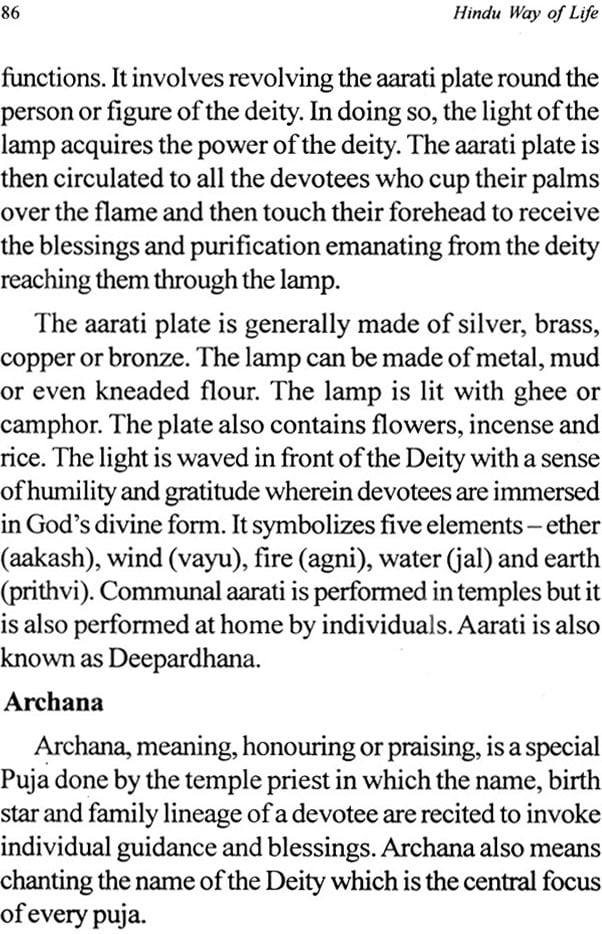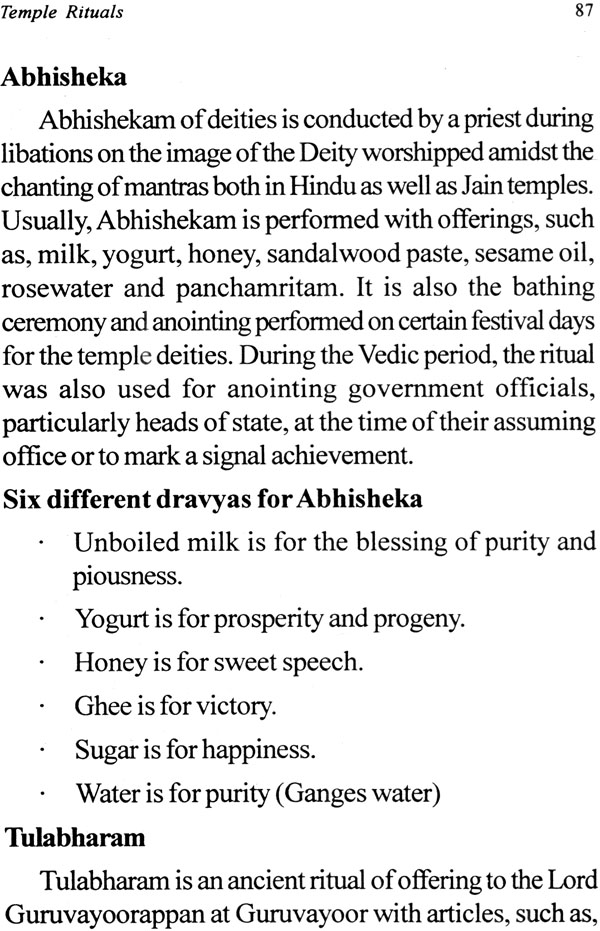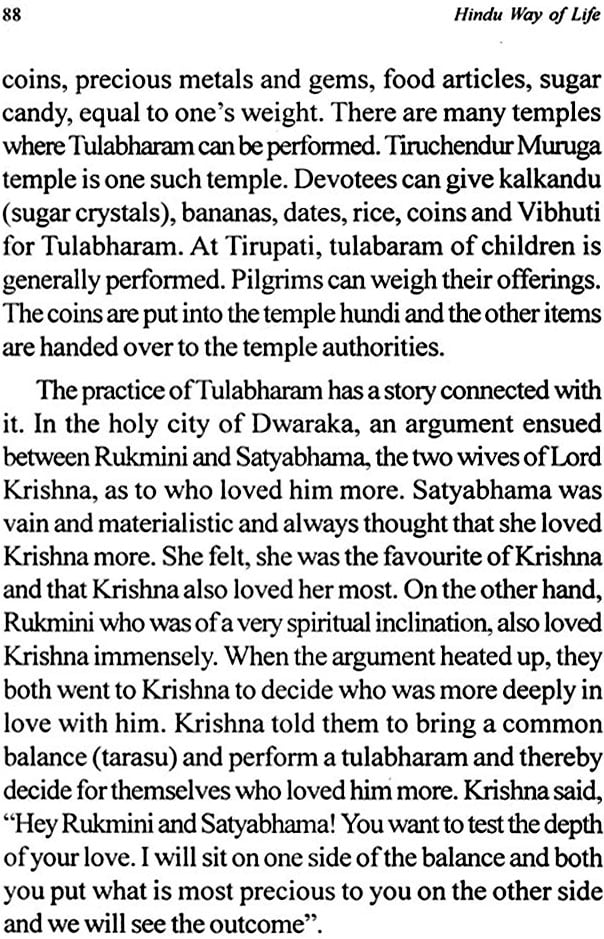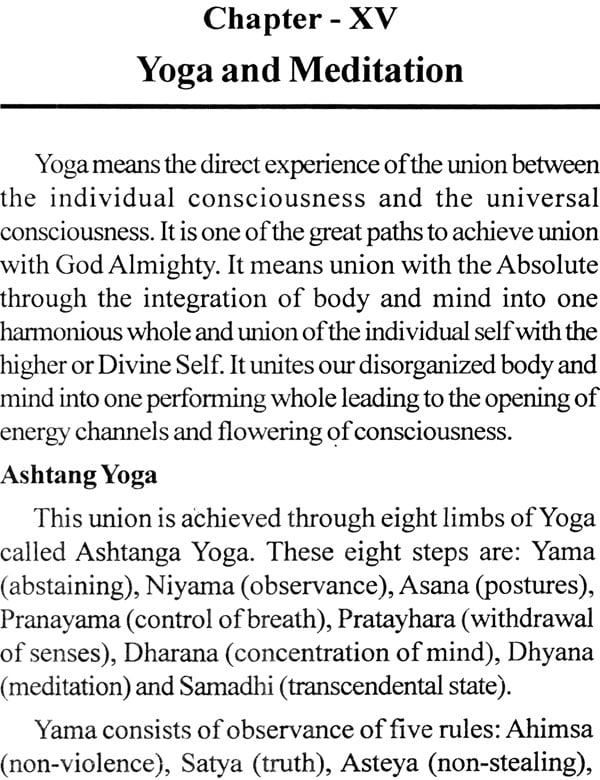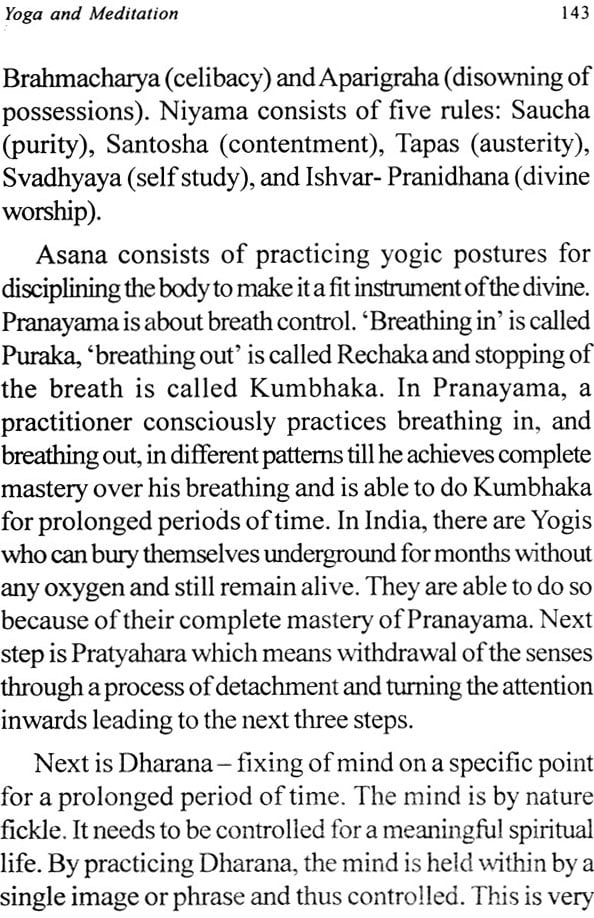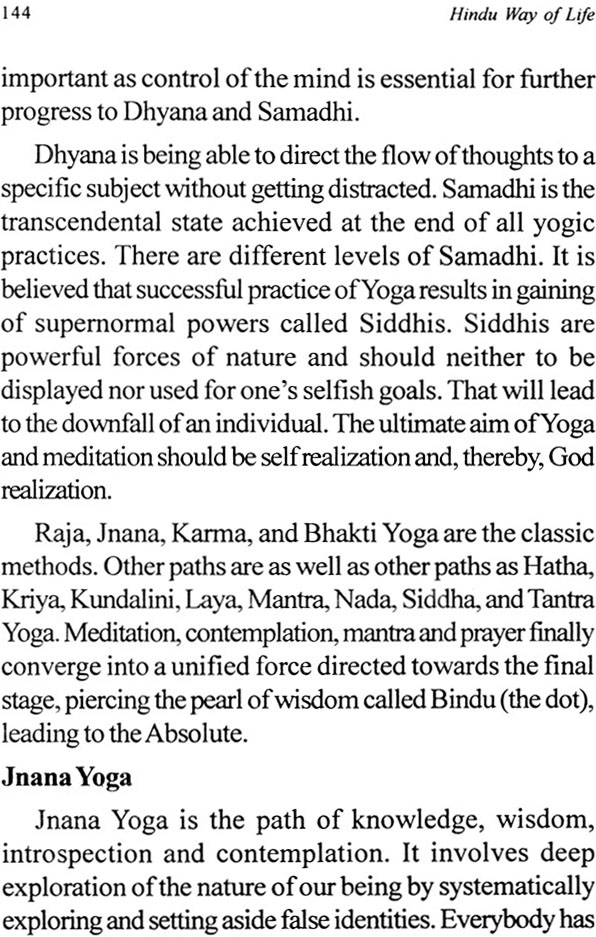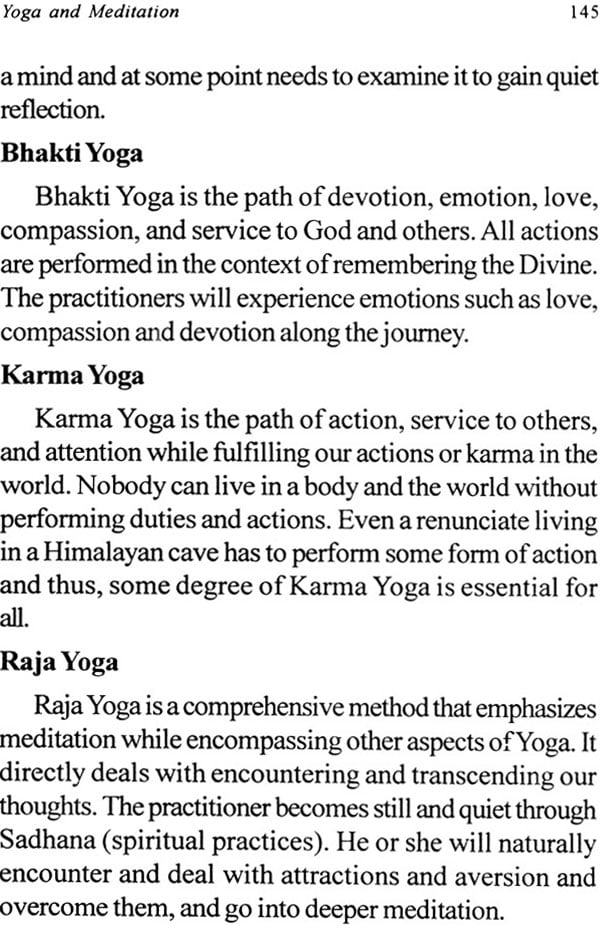
Hindu Way of Life
Book Specification
| Item Code: | NAL135 |
| Author: | C.K Gariyali |
| Publisher: | B.R. Publishing Corporation |
| Language: | English |
| Edition: | 2013 |
| ISBN: | 9789350500828 |
| Pages: | 165 |
| Cover: | Hardcover |
| Other Details | 7.5 inch x 4.5 inch |
| Weight | 240 gm |
Book Description
About the Book
Sarvepalli Dr. Radha Krishnana said that Hinduism is a way of life. It is so because for Hindus , the spiritual ,sacred and secular aspects of life are highly intertwined. It is impossible to distinguish where one ends and the other begins .Hinduism or sanatan Dharama is the world’s oldest living religion and hence its temples, idols, temple –arts and ritualistic practices are a legacy of mankind. It is a living, unbroken testimony as to how the concept of god evolved to its present form in the human mind . Hinduism is not for Hindus or Indians only; it is a world heritage .the book is an attempt to document and preserve the body of knowledge about traditions, rituals and practices in simple words for the posterity. Hindu society hitherto rooted in most ancient traditions is now in a state of transition and much of this knowledge is getting eroded. This book is an attempt by the author to document how Hindus have been living for millenniums, trying to connect their mundane lives with the divine.
Dr. C K Gariyali a retired officer of Indian administrative service was born in the spiritually vibrant valley of Kashmir, into a pundit family, tracing its linage to sage patanjali .Her grandfather shri Haldar Joo gariyali was a Sanskrit scholar.
Dr Gariyali was drawn to god at a very young age and was initiated into Gayatri mantra by her father. As a teenager she came under the influence of living master of the Kashmir shaivism. Swami Ji introduced her to ‘Zen Buddhism and the philosophy of shri ramana maharishi. She has received blessings from shri j kridhnamoorthi, acharya Rajneesh, shri Mahesh yogi , mother Teresa , pope john Paul II and bhakti ma a silent Himalayan saint.
She is a student of contemporary religions and has profound respect for all spiritual thinking. Yet she is fascinated by the all encompassing nature of sanatan dharma, (Hinduism). She considers sonatas dharma the most ancient continuous and open pursuit to know the ‘Almighty ‘. This book ‘Hindu way of life is her attempt to document for the posterity – what being a Hindu has meant to people for several millenniums.
The book on Hindu way of life is a labour of love devotion and dedication undertaken by Shrimati chander kanta gariyali a retired IAS officer. This book deals with well and widely known and believed traditions, rituals, samskaras (cultural values) ,practices and legends of the primordial Hindu religion and culture . Hindu religion is the oldest surviving religion in the world, inspired by the divine revelations (by the breath of god). The ancient rishis (saints, sages and seers) sung these revelations in the forests like Naimysaranya, vedaranya ECT. On the banks of sacred rivers like Ganga, Yamuna, Brahmaputra ,Narmada ,Tapti ,Mahanadi, Godavari ,Krishna, Cauvery and tamrabarni in different parts of India from Kashmir to kanyakumari from the ran of the Kutch to bay of Bengal. They gave the divine immortal message through songs, words and deeds, many thousands of years before Moses, Gautama Buddha and Jesus Christ. The collective wisdom of these sages was obtained through their intense penance (Tapsya) in the forest. Their collective wisdom ultimately evolved overt aeons of time and crystallised in what to known as Hinduism today also known as primordial religion, the Sanatan dharma (eternal and universal righteousness).
Unlike other religions of the world, Hinduism did not originate from a single person, a single book, or at a single point in time. The religion and philosophical literature of Hindu religion is vast diverse and covers thousands of years of accumulated spiritual experience of a large number of Hindu sages and saints. Therefore it is difficult, almost impossible for a beginner to know where to start from to learn about the Hindu religion and its lore without going through several volumes of Hindu literature. Through, there are numerous books available on Hindu religion; most of them are not suitable for easy study by the beginners. The language and the writing styles of most of the books on Hinduism are too complicated and complex for beginners to understand.
In this remarkable book, ‘Hindu way of life ‘,the author has met head on two pressing challenges of our times: (1) how to cull and distil the essential and fundamental features of the enormously vast, deep and rich Hindu heritage , so varied in scope ,within the narrow compass of a small volume in an scope within the narrow compass of a small volume in an easily understandable highly engaging and readable style and (2)how to make it highly rational objective interesting relevant and meaningful to our new generation of Indian youth.
All our children are growing up fast with the full impact and influence of westernization in all its best and worst forms and manifestations and yet at the same time are deprived of the opportunity to know, understand and appreciate their own rich time tested spiritual heritage and their own true inner selves. Likewise most Hindu adult men and women many of them professional in their own field yet tragically unaware and understanding the intellectual sensibility towards the rich and great religious and cultural traditions of Hindu religion so profound with its illuminating wisdom life nurturing and life sustaining ethical moral values and splendid aesthetic expression will also find this small volume on Hindu way of life highly rewarding. The purpose of this book therefore is to assist the students of all ages to assimilate the fundamental concepts of Hinduism and to provide them with a road map for the further spiritual journeys in the wonderland off Hindu religion and culture if they so desire.
Shrimati chandler kanta Gariyali has fully and succinctly explored with great clarity all the visible and tangible aspects of Hindu religion and culture: the scriptures the epics the symbols and symbolism teachings the deities the important Hindu samaskaras. Teachings the deities the important Hindu samaskaras the vital Hindu paradigms such as the goals and the stages of life.
In short she has given a detailed account of the Hindu institutional machinery which constitutes the hardware of Hindu religion and culture. Likewise she has also given an interesting account of the illuminating software of Hindu religion and culture that has been running the great machinery of Hindu society from the dawn of history to the present day. She has successfully unravelled the genius and vision of Hindu religion flowing down from the wisdom and the wizardry contained in the Vedas and gradually unfolding itself through the course of Hindu history showing the secret of its universal cosmic outlook and consciousness. This driving impulse has always throbbed across centuries and this deathless impulse has enabled Hindu religion and society to keep reinvigorating and re-inventing itself again and again and from time to time. The learned author has rightly underlined the purity of reason and true knowledge that are absolutely essential for seizing the essence of the brotherhood and oneness of all mankind which constitutes the bedrock of Hindu religion.
The Hindus have always felt and believed that the essential self the vital essence in man is the same as found in all forms of life a tiny goat an ant an elephant and a tiger and a butterfly indeed is sane as that to be found in the whole universe. Bhagvad Gita declares ones the one’s full of wisdom may the true pundits be bold and relate to a learned Brahmin a cow or an elephant or a dog or a dog eater with the same equanimity of vision and evenness of love.
The mainstream Hindu is comfortable with the cult of devotion and with idol worship both at home and the temple. He may even have his Isht devata (favourite deity) kul devata (family deity) gram devata (village deity). He may worship objects of nature such as plants and trees water and rain or celestial bodies’ including the sun the moon and the planets.
Hindu Samskaras are the rites or practices enshrined and ordained in Hindu scriptures to guide an individual towards a proper sense of duty and obligation during the various stages of life they purify the mind and intellect by inculcating truthfulness in the mind and purity and generosity in the heart. They create an urge for morality and righteousness. Since anger destroys noble thoughts greed leads to evil actions pride hinders normal growth and arrogance leads to irrational and cruel behaviour, samskaras are meant to act as signboards on the path of life directing and guiding travellers on their earthly journeys thus eliminating flattering confusion at the crossroads of life. The author has have dealt with the subject of Hindu samskaras in a thorough and interesting manner.
It is vitally believed by Hindus that plants affect the events in one life and that they can be pleased by worshipping different deities. For Hindus performing rituals to gods ancestors undergoing fasts austerities and giving alms is part of their day to day religious and cultural existence. This book has discussed the HINDU WAY OF LIFE in the context of temple practice idol worship and sacred symbols astrological impact of planets and associates rituals and practices. The author has put together various nuggets of information and given a systematic account of what taken place inside the temple.
This book discusses the rituals performed to gain strength from the worship of appropriate gods/deities so as to mitigate the adverse effects of certain planetary conditions existing in the birth charts .much of this knowledge and information passed on from generation to generation through word of mouth by family priests’ grandmothers and other elders. This knowledge about propitiating the planets and celestial bodies by performing simple religious and ritualistic remedial measures has been painstakingly collected and preserved by Hindus for several generations is now in danger of being lost.
Shri raghavan an eminent astrologer of Chennai with his detailed knowledge and understanding of these ancient traditions has enormously contributed to this book by pointing out the doshas or defects in birth charts as well as suggesting suitable parihara or remedies so as to effectively counter them.
After going through this sample of a very beautiful book i cannot help quoting the following truly sublime words of Albert Einstein, “the most beautiful thing we can experience is the mysterious. It is the source of all true art and science .he to whom this emotion is a stranger who can no longer pause to wonder and stand wrapt in awe is as good as dead :his eyes are closed. This insight into the mystery of life coupled though it be with fear has also given rise to religion. To know that what is impenetrable to us really exists manifesting itself as the highest wisdom and the most radiant beauty which our dull faculties can comprehend only in their most primitive forms this knowledge this feeling is at the centre of true righteousness. In this sense in only i belong to the ranks of devoutly religious men.
Family I would love to conclude this preface by quoting the following inspiring words of Annie Besant (1847-1933) which will continue to ring across centuries mocking at time remaining unaltered and imperishable, make no mistake without Hinduism India has no future. Hinduism is a soil into which India’s roots are stuck and torn out of that she will inevitably wither as a tree torn out from its place and if Hindus do not maintain Hinduism who shall save it? If India own children do not cling to her faith who shall guard it? India alone can save India as India and Hinduism are one”
| Acknowledgement | v | |
| Preface | vii-xiv | |
| 1 | Introduction | 1-2 |
| 2 | God Realization and Idoi Worship | 3-20 |
| 3 | Vahanas for the Gods | 21-27 |
| 4 | Planets -Celestial Bodies and Saturn | 28-43 |
| 5 | Doshas or Defects in the Birth Charts | 44-75 |
| 6 | Gem Stones in Vadic Astrology | 76-84 |
| 7 | Temple Rituals | 85-90 |
| 8 | Temple Offerings | 91-96 |
| 9 | Why Hindus Conduct Havan | 97-104 |
| 10 | Pilgrimages and Offerings | 105-109 |
| 11 | Hindu Samskaras During One's Life Time | 110-116 |
| 12 | Sacred Music and Chanting | 117-123 |
| 13 | Plants and Trees Sacred to Hindus | 124-133 |
| 14 | Sacred Symbols | 134-141 |
| 15 | Yoga and Meditation | 142-149 |
| Conclusion | 148-149 |
